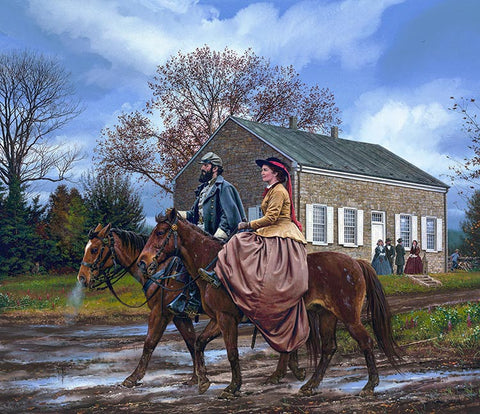Jackson Meets Little Sorrel
by John Paul Strain
In the spring of 1861 Col. Thomas J. Jackson was sent to the Confederacy's northern most point, the town of Harpers Ferry, to take command of the troops there and secure the armory and arsenal. Jackson's job was to organize and instruct the eager men ready to defend Virginia. Jackson's appearance was at first a little disappointing to the soldiers who did not know him. He was described as wearing his faded Virginia Military Institute uniform, with a blue cap pulled down concealing his features. A day or two after Jackson's arrival, an eastbound livestock train was seized, and a number of horses were recruited to the Confederacy. The horses were taken to the river for water, near the picturesque landmark where the Potomac and Shenandoah rivers meet. Jackson, being without a good mount, picked out two of the horses with the help of Major John Harmon. One of the horses was a powerful, large sorrel, and the other gelding was small and well rounded. Within a day Jackson found the larger animal skittish with a jarring gait, while the smaller sorrel had a smooth and easy gait with an even temperament. And so began a relationship between horse and rider, that would become one of the most recognizable partnerships of the war. They would soon be known as General Stonewall Jackson and his horse Little Sorrel.
"I enjoyed depicting the moment when Jackson and Little Sorrel first met. Little Sorrel had a special character that seemed to fit with his owner. Outwardly he wasn't considered a flashy horse, but like Jackson, he proved his worth not by how he looked but by how he performed. Little Sorrel had so much heart and endurance, that Jackson's staff often had to remind him when their own horses were played out. Little Sorrel also had quite a personality. It was said that often the horse would lie down on the picket line with General Jackson feeding him apples. After surviving the war, Little Sorrel was described as a rascal with a mouth that could undo latches, let down bars, and liberate every horse in the barn. And like his earlier master, he would lead his command into new fields of opportunity, removing fence rails if need be."
| Style | Image Size |
| Archival Paper | 15" x 20" |
| Studio Edition | 24" x 18" |
| Classic Edition | 24" x 32" |
| Executive Edition | 30" x 40" |






Share this item: